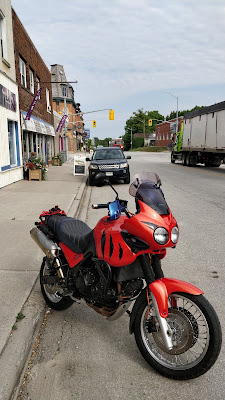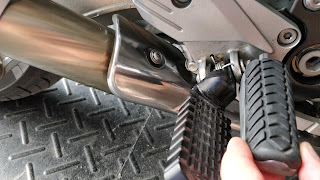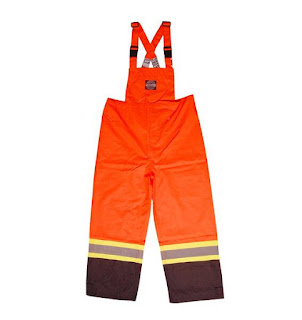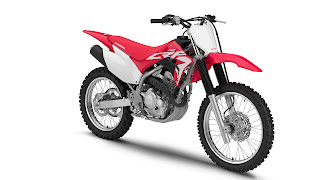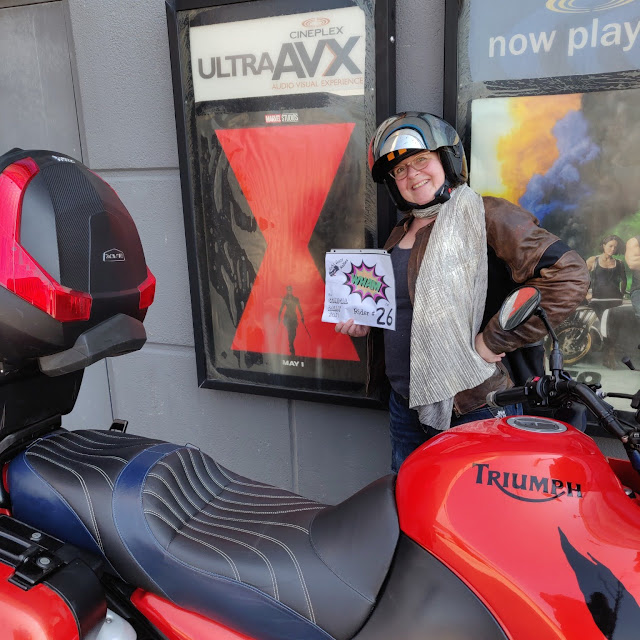We were up early on Friday morning getting ready for the Lobo Loco Comical Rally. This was a tricky one with super-hero themed locations but without a set start and finish location. It sold out well before the start day and had people from all over the place participating in it. A long distance rally like this gives you a list of theme based locations you have to research and plan to visit in a set time period. This one also had a minimum distance requirement of 400kms in 12 hours.
For us we were looking at a warm (28°C), sunny day in Southern Ontario. Our plan was to create a ‘skeleton’ map of where we wanted to go and then research locations on the route that would get us points. Because this rally was a human-focused one, it made sense to head into population to find locations, so I elected to make a route that would lead us to Niagara Falls eventually. This would mean riding in the dreaded “Golden Horseshoe” – the most populated area in Canada and usually a sure way for me to lose all hope in humanity.
I usually aim away from population when I ride. Sitting in traffic and dicing with distracted drivers isn’t on my to-do list when I go for a ride, but one of the advantages to doing a rally is that it pushes you outside of your comfort zone. In this case it would help me hone my highway riding and traffic management skills.
The plan was to take the new Concours 14 on the trip but after a pre-rally ride on it we got home and looked at the Corbin seat on the Tiger and decided to take the older, less dependable and less long-distance touring ready bike simply for a saddle that doesn’t feel like a sadist’s dream. The Tiger also has nicer foot pegs for pillion and wasn’t giving me any reason to doubt it so I spend the day before making sure everything was tight and ready to go.
By 10am we were on the road getting points. We looped through downtown Elora to catch our first super-hero bonus (IRONMN1) and then bounced over to Fergus to get our first villain bonus at the Lutheran church there (LUTHOR1), then it was down to Guelph to catch a Spiderman themed stop (a science building at a university) before heading on to our first comic book store stop at The Dragon in the south end of the city. We’d hoped to also do a motorcycle themed comic book cover in the store but thanks to COVID they were running on reduced hours and weren’t open yet.
We’d done a lot of research and planning for the rally but you’ve got to be ready to pivot while you’re in a timed rally in order not to burn time. Unfortunately, at that moment the Tiger decided to get temperamental and wouldn’t start. I finally got it going again so we decided to grab a MOVIEP bonus for a superhero themed movie poster at a theatre nearby instead (you could only pick up 3 stops in teach location).
The Tiger wouldn’t start again after stopping at the theatre (turning over but not catching when hot). I was now anxious and worried that we’d get stranded while far from home during a never-ending pandemic. It finally started and we pulled over at a local Starbucks to have a coffee and a think. The bike was working perfectly other than the hot-start issue so we decided to press on. Because we parked the bike for 15 minutes while we had the coffee, the Tiger fired up no problem – so it starts, just not immediately after you turn it off. This is a problem in a long distance rally where you’re starting and stopping up to 25 times, but a manageable one.
South down Highway 6 we immediately got stuck in traffic coming off the 401 mega-highway. It was starting to get properly hot now but once we got moving the temperature was bearable. We were going to stop at Flamborough Patio Furniture to get a photo of one of their giant chickens (the INHULK bonus was to get a photo of an oversized road-side attraction), but there was no place to safely stop and I’m very conscious of safety when we’re rallying, so we pressed on to Terra Greenhouses where we got the GOBLIN1 bonus for finding garden gnomes. We stopped long enough that the Tiger fired up no problem – 10 minutes seemed to do the trick, so on we pressed to Hamilton and our next three targets.
Another science building stop at McMaster University almost got us the REALHOx real hero bonus (get a real-life hero to sit on or stand by your bike) when a nurse came out of the hospital still in scrubs on her way home, but we couldn’t find her once we pulled into the university parking area. After McMaster we headed downtown looking for a Wonder Woman bonus (stature of a woman), but construction meant we would have been sitting in traffic for 20 minutes trying to get there so we bailed, hit the Levity Comedy Club for a JOKERx bonus before riding out along Hamilton’s rough dock area.
The next target was Do Eat Sushi in Grimsby where they serve octopus on the menu (the OCTOPI Doc Octopus villain bonus!). We stopped for an excellent lunch at Station 1 across the street before pushing on to St. Catharines. Our Skills Ontario GIS medal winning son was at home so we had him look up an alternative Wonder Woman statue we could do and he found a great one! St. Catharines was the end of the Underground Railroad that helped slaves escape the land of the free south of us. Harriet Tubman was a real-life wonder woman who helped free hundreds of slaves and then went back to the US to fight for the Union in the civil war. Her statue in St. Catharines, where she lived for a time, was in a meditation garden on the side of a small church in a rough area of the city, and it was lovely and all the better for it because we were originally going to just grab a statue of a queen instead. Canada has a lot of hidden history like this but queen statues are a dime a dozen.
From Harriet we worked our way through St. Cats getting a Peter street and a Parker Street along with another science building to complete the Spiderman combo bonus (Peter & Parker streets, GOBLIN, OCTOPI and science building – so all the Spiderman – points).
We headed out toward Niagara toward Queenston Heights for our second wonder woman statue (
Laura Secord this time) but the canal was closed while a massive ship with what looked like huge steel building construction on it closed the way over. Some cars were turning left so we followed them down the canal to the next bridge and got over as the big ship was entering the lock upstream. It was cool to see but slowed us down. I missed a turn to get on the highway and we ended up travelling through
Niagara wine country instead, which was an improvement.
As long as we didn’t stop the Tiger and expect it to start right away it was flawless, though the clutch was starting to make some odd noises. Maybe it’s time to change the sparkplugs. We collapsed in a heap on the grass in the
Queenston Heights across from Laura’s statue at 5pm. At that point we’d done about 160kms and hit 14 locations. Our initial plan was to do 24 locations (one under the 25 limit) and continue on to Niagara Falls before looping back and catching our final stops in Cambridge and Kitchener on our way home, but my phone was acting up and the bike was causing worry and I was concerned about our stamina (over the past 3 years our family has faced cancer and heart surgery).

As we sat there with our boots and socks off (I took my pants off too), we had a picnic of apples, granola bars and water, cooling off and stretching, we made a decision to call it. With better circumstances, a less questionable bike and better stamina on our part I think we could have aimed for a 10k score, but for this one my main goal was to finish and do it with a smile on our faces.
Finishing meant we had to do a minimum of 10 stops and cover at least 400kms. The distance requirement was going to be tricky and we wouldn’t meet it by retracing our steps. Just before my phone died I mapped an alternative route that would have us dodge west on the 403 to the 401 before heading home on the highway. Going this longer way around on the highway would mean we wouldn’t be on the road so long (but it would be at speed in rush hour traffic) and we’d just get over the distance requirements.
We set out about 5:30pm and bombed down the QEW without any slowdowns. When we got to the bypass around Hamilton things ground to start-stop with compression waves of impatient people cutting each other off and making it worse. We sat amidst the rows of idling SUVs, minivans and trucks, all spewing carbon into the atmosphere while everyone made a point of slowing things down in hopes of getting themselves a few feet further down the road. In circumstances like this it’s hard not to see every GTA rush hour as a metaphor for why we’re willing to make the world uninhabitable just to get ourselves a bit further down the road. It takes a special kind of blindness to not see that when you’re sitting in it every day.
The jackass in an Audi wagon with fifteen grands worth of carbon road bicycle on his back bumper who ran right to the end of a lane before cutting in front of the row of traffic was in the majority. Nothing makes people worse than there being
too many people, and there are
more too many people in the world every day.
I’d suggest lane splitting for bikes but after watching Ontario drivers fail to indicate and drive irrationally just in order to get ahead one space in traffic, I don’t think Ontario can handle lane splitting or filtering of motorcycles, we don’t have the culture or the driving skill to do it safely.
Once clear of the idiocy that is Canadian city driving (there’s a reason the only accidents Ewan & Charlie had when they rode around the world
was in a Canadian city), we made tracks on the 403 away from the apocalyptic Golden Horseshoe. The Tiger doesn’t have much in the way of wind protection (it’s basically a tall, naked bike), but the motor is a treat and we bombed down the 403 to Woodstock where we stopped to fill up at about 7pm. The Tiger was managing over 50mpg two up with luggage. The long ride into the setting sun had dried us out so we grabbed a Booster Juice and stretched before hopping back onto that lovely Corbin saddle for the final run home.
The 401 is a lot like Mad Max but without the speed limits. As we got out onto the near-empty mega-highway we merged with 18 wheelers already doing 120km/hr and made tracks for Kitchener. We got there in what felt like a matter of minutes and ducked off at Shantz Hill to take Regional Road 17 past the Waterloo Regional Airport and home.
The sun was low in the sky and the sunset was beautiful. We passed through several small, Germanic communities around Kitchener and I figured at least one of them would have a Lutheran church so we could pick up another LUTHOR bonus, but all the little village churches had switched to United Church and I didn’t have it in me to go hunting this late in the day.
We pulled into the same Esso station in Elora that we’d left at 9:40am at 8:30pm and 407kms later. If you factor in our three extended stops, we were in motion for 9 out of those ll hours averaging 45km/hr including 14 stops for points.
If you’ve never done a long distance rally like this you’ll find that you’re exhausted at this point. Riding a bike is much more physically taxing than driving a car, especially an air conditioned one on a hot day. We’d made a point of hydrating whenever possible but you always end up in a deficit doing an event like this.
This was our first timed rally as a team and we both have a much clearer idea of what’s needed to be more competitive next time. An ergonomically sorted Concours would be a better tool for this kind of long distance work, especially covering the highway miles, and it would erase bike mechanical worries. Stopping for hydration and to sort ourselves out is a good idea – being frantic and chaotic on something like this doesn’t help you maximize points. We got penalties for misspelling not putting addresses in some of our emails, though our photos were good so we’ve got that down.
I had to get the
Send Reduced App on my generic OnePlus Android phone in order to meet the size requirements for attachments which adds extra work to sending in stops. Iphones and Samsung Android phones do these file reductions automatically in their email programs so that’s one place to trim wasted time and maximize scores.
It took us 9 hours in motion to make 14 stops. You don’t want to rush stops because you can lose points making mistakes, but you also don’t want to end up with stop lag. An efficient stop would probably be a couple of minutes if you’re finding a safe place to stop, parking up the bike, getting the rally flag ready and taking the photo and sending it correctly. Some of our stops lagged up to 10 minutes. If we’re running for maximum points we’d need to tighten up our stops, but retaining the breaks is a good idea to maintain hydration and limberness.
The biggest place to pick up points would be in building our stamina so we could run competitively for the full 12 hours. This would require physical training. There is also an element of circumstance/luck in a long distance rally. If you get stuck in traffic or COVID reduced business hours you end up missing points that might otherwise fallen to hand. I’ve always felt that if you practice your luck it will improve; experience makes luck happen.
Our rally prep is strong and our ability to pivot away from bad situations while in motion was good. If we can improve our tools and stamina we could aim for a 10k+ finish points wise which would put us mid-pack.
The Concours is a better bike for this kind of work compared to the 80 thousand+kms, older and cantankerous Tiger, but I haven’t ergonomically tailored it to our needs yet. A phone that streamlines submissions would help as would an on-bike navigation system rather than me trying to do all that through my generic and increasingly disappointing OnePlus Android phone.
TomTom makes a moto-specific GPS system (
so does Garmin) that would allow me to create a full rally route rather than the limited number of entries Google Maps allows. G-maps is also (like all Google apps it seems) a poorly designed afterthought designed to collect user data rather than provide an optimal service – we pay for free in many different ways. Having a navigationally specific tool would make for much more streamlined directional plan.
Our goal was to finish the rally and we achieved that. By building on our strengths and consolidating this experience and improving our tools and processes, we’ll be able to aim for a more competitive result next time.
Here’s our rally planning spreadsheet:
If you’ve never tried a long distance rally, give it a go. It’s a great way to hone your bike craft while riding with purpose. You also end up finding things you might not otherwise known about, which is one of my favourite things about it.
Below are the final scores. We finished, but just. Check out the mileage on the top runners! Managing over 1100kms in 12 hours means you’re averaging over 90kms/hr for 12 straight hours. I can’t quite wrap my head around how that’s possible if you’re still stopping for points all the time. Even if you’re pulling up, taking a photo, sending it and then immediately going again, you’d have to be really moving to manage that. Even our perfect run wouldn’t have gotten us in the top 20. The skill and stamina shown by the top runners is incredible.
from Blogger https://ift.tt/3kSrskq
via IFTTT


























